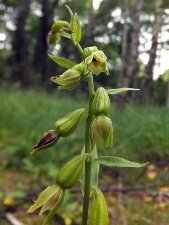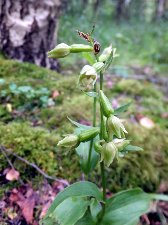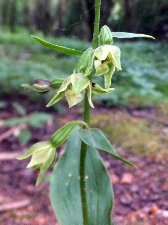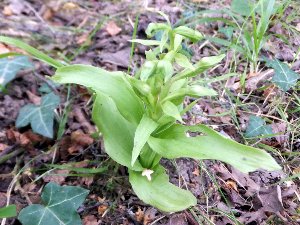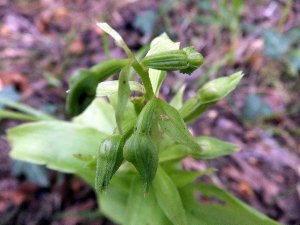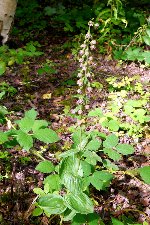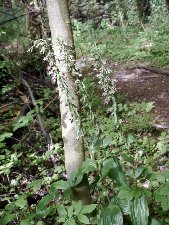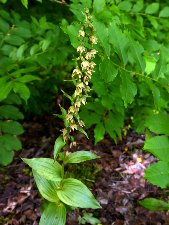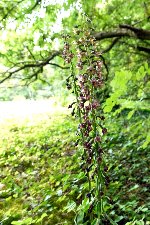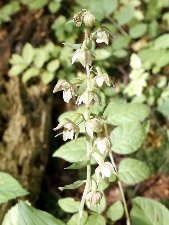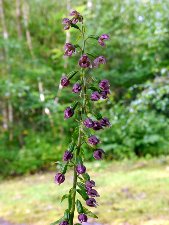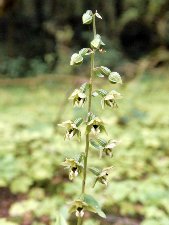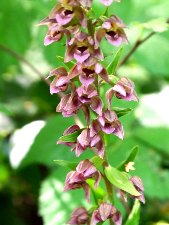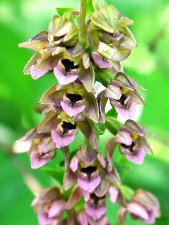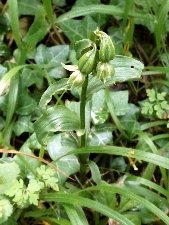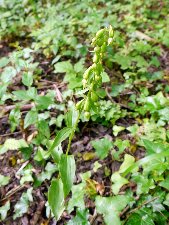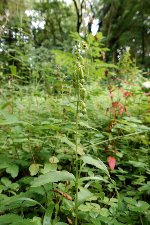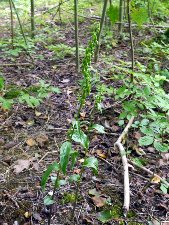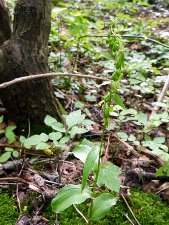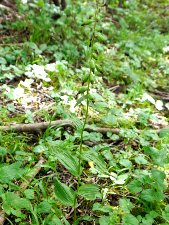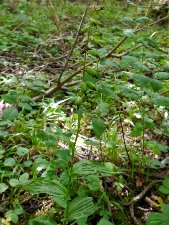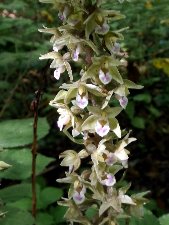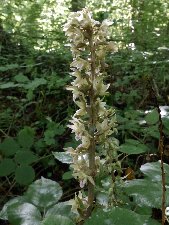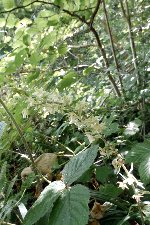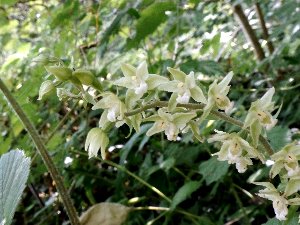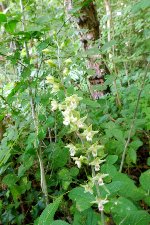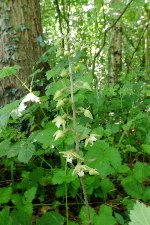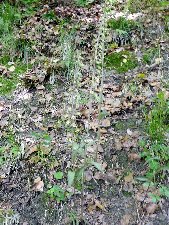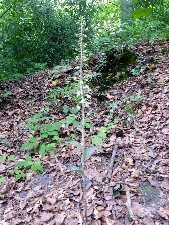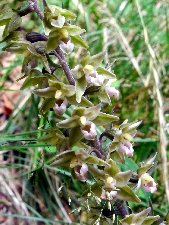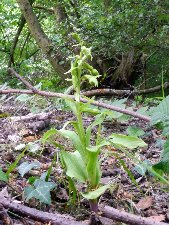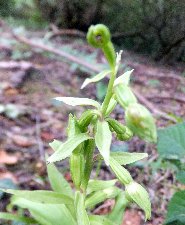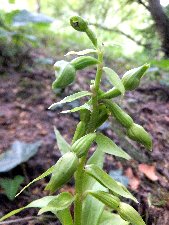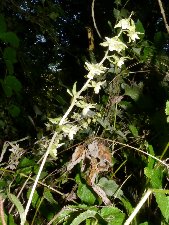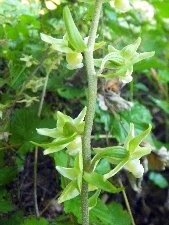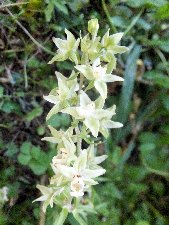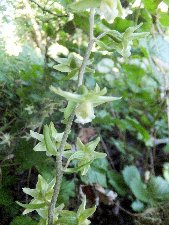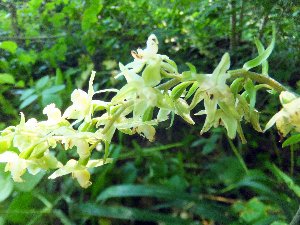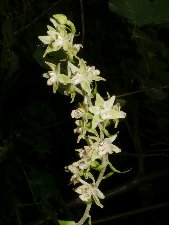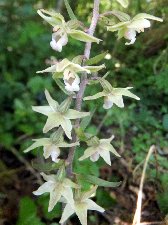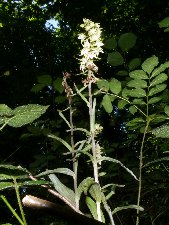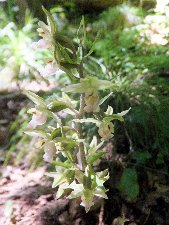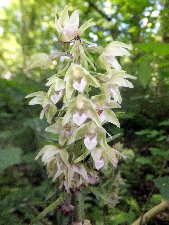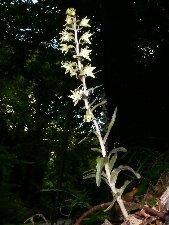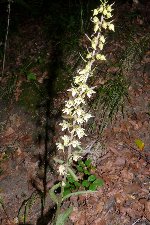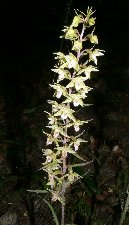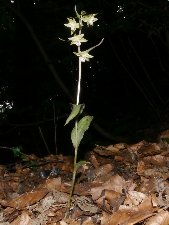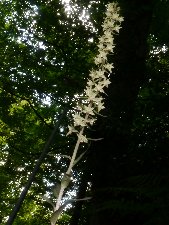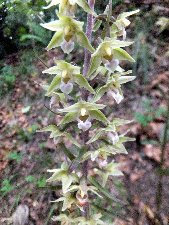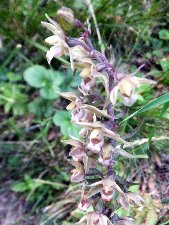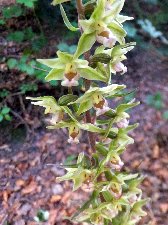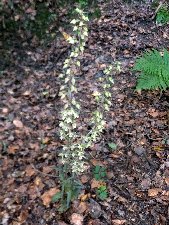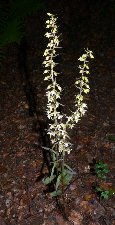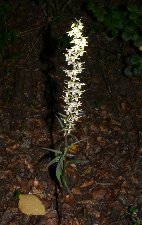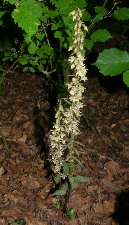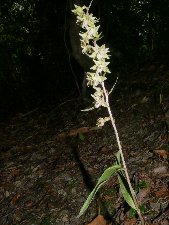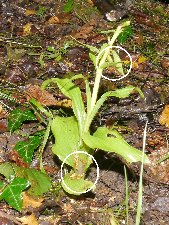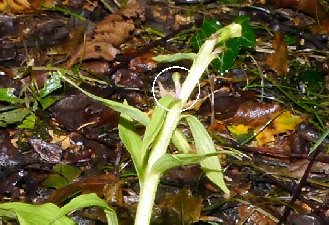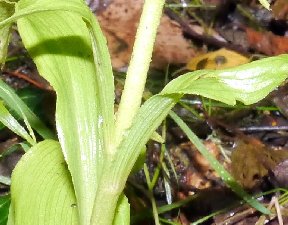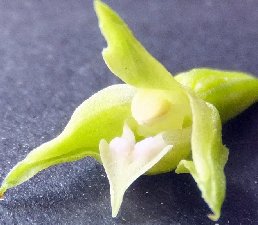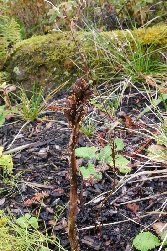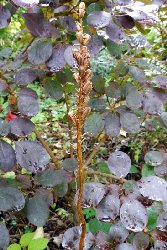|
|
|||||||||||||
|
|
|||||||||||||
 |
|
Back here once again - no real reason as the Dune Helleborines will have gone over and the Green-flowered Helleborines were well nibbled last visit. However, I do find some Green-flowered Helleborines in reasonably fine fettle. A couple even have slightly open flowers. However mixed with those and some Dune Helleborines nearby is an unusual plant. It is clearly a helleborine, with bright yellow-green leaves, but only a few inches tall despite quite a few flowers on the spike. The leaves are uneaten, unlike the dark-green leaves of the surrounding GFH, and they are long and more lance shaped than ovoid. There seems to be some rather long bracts higher up the short stem. About ten unopen flowers are present. They are not very pendulate like GFH, and some are held horizontal. When I put an image up on the net for common the one reply was "Green-flowered" without any explanation. It probably is an aberrant form, but which species. It is so different from the neighboring GFH I just cannot believe it is that species. I could be wrong, so a return visit is needed in a week's time!
I now have a Panasonic G5K camera, and where better to get in some practice. I am hoping that I can get some shots of the nice all-red Broad-leaved Helleborines seen here last time, but in just a week flowering has progressed quite noticeably. Many fine plants have gone over. Even so, there is plenty of opportunity to play with the camera and get some good clear full length shots of the helleborines and see how close-ups pan out. Some plants have quite tightly packed flower spikes, while other spikes are quite loose. Strolling around I find some new plants along a path on the far-side of the open square. Nothing new in these photos, apart from some neat examples of the colony here, but I am reasonably pleased with the results of a first excursion with a new camera.
Marford Quarry 5th August 2016 Another test for the new camera with a hunt for more Green-flowered Helleborines in their shady spots. I revisit those in the glade, after finding a rather stunted example in the dell along the accessibility path. I secretly pat myself on the back for spotting this. Up the hill from the glade the GFH are in quite fine condition, and I find about 20 scattered under the trees on both sides of the path. They seem better and more numerous than other years.
Severn Valley Country Park 6th August 2016 We first visited The park in 2013 and counted in excess of 40 spikes in the woodland where the Violet Helleborines grow. We returned in 2014 and found none! So I am hoping for a degree of success this year. The boards around the park mention Bee Orchids, and it seems this may not be an optimistic claim. On the way down to the river we pass an unmown patch with some orchid seed heads which are most likely this species. We make our way back along the river bank, and this provides the find of the day. On the woodland edge is a cluster of six medium sized plants, and these are very pale. In fact some of them lack any violet colouration at all; none on the flowers, leaves or stem. The others have the bare minimum of colour on the stem. Are these an unrecorded variety with no mention in the reference books, or is this within the expected normal variation of the species? I have images put this up on the net for opinions.
Today we are only visiting the roadside colony. There is a group of nine Violet Helleborines at the first stop and three at the second, with nice tall specimens. The numbers are not as great as when we first visited here in 2013, but probably equal to the two subsequent years. They all look in fine fettle, though the flowers have only just begun to open, and some plants not at all. The main reason for coming here is the Var, rosea seen last year, but it is nowhere to be seen. We are surprised though, on returning to the car. Right next to us, on the open grassy bank are three more Violet Helleboriness which are in full flower. One of these has especially rich coloured flowers. Is this a consequence of the higher light levels - this bank is quite exposed compared to where the others grow?
Alyn Waters Country Park 11th August 2016 A visit to see the odd Helleborine seen 6 days ago in the hope the flowers are open. They are not, but it has developed somewhat, growing to about 9 inches/22cm, and has revealed more about itself. There are five large broad lance-ovate leaves, yellowish green in colour, and possibly even arranged spirally around the stem. The flowers and bracts certainly are. The stem, bracts and the flowers are the same overall colour. The stem seems to be hairy, while the ovaries are not. Significantly, in my opinion, the stem base of the ovaries is a reddish violet colour, and the ovary is untwisted. This should rule out Green-flowered helleborine as the species, while the the base of the stem is noticeably purplish without any obvious sheathing leaf. The flower appearance in bud does resemble the Green-flowered species, but the eight flowers here are held horizontally or more upright, with only one currently pendulous. Another visit looms - I need to see the flowers, because I cannot see which species may be. I am swaying towards an aberrant Dune Helleborine that is a late developer, but the growing pattern is so unusual. Otherwise I will be looking at other possibilities (perhaps even exotic possibilities), so look below for another report! Severn Valley Country Park 12th August 2016 I want to have another look at the Unviolet Helleborines again and get some more photos. I am a bit disappointed with the batch from last week - at all the Violet Helleborine sites inadequate natural light is a problem. Automatic (or manual) settings mean a long exposure time leading to some blurring on a number of photos - either due to handshake or the minutest bit of breeze. This time I take a small pocket-sized tripod, but undergrowth, uneven ground, and sloping ground render this rather ineffective, so I have to resort to flash for some photos. I don't like this as it may not produce true colour, but makes up for that in clarity to an extent.
A quick check of the woodland reveals more (typical) Violet Helleborines than we saw last week. At first I am surprised that these were missed as they weren't growing in concealment, but with sunlight playing through the canopy appearances can be deceptive. One looked like a bramble flower more than and orchid. It's still a poor show compared to our glorious first visit here when passersby would have heard comments like "here's another four, ...... no five". Coalbrookdale 12th April 2016 (SJ 6676404411 SJ 6689503943) Back here again in the vain hope that we missed seeing the Var rosea by accident last week. It was not to be, but the main roadside Violet Helleborines are considerably more open this week. We spot one more on the roadside group, which now numbers 10, and one more near the `lay-by'. Some quite nice plants here. There must be more up in the woods but you just cannot see them from the road due to the steepness of the bank. Pencil in a wander through those woods for another year - you never know.
Then it's across the valley to the woodland path. and we tackle this from the opposite direction to usual - downhill first. We see nothing until we come to the fork in the paths, and where we saw an absolute beaut last year, in terms of size and colour, there are five this year. But none of them is that beaut. We are surprised that these haven't been broken off at all, as they effectively grow on the path. Perhaps why there was only one decent specimen here last year. On the slope behind these at least four more can be seen, demonstrating that they do not just grow pathside in the woods. Alyn Waters Country Park 19th August 2016 A final visit here for the year, especially to see if the mystery helleborine's flowers have opended; just one will do. But I am disappointed. The very top of the stem has been nipped off, and all the flowers have dropped off. There is just one seed pod left, and that does not really seem to be developing. The physical appearance of this individual plant is ambiguous. I looking further afield, there have been reports of plants resembling European species Epipactis muelleri and E. confusa growing in the N.E. of England, though there has been no confirmation of these. However neither of these fit the bill. E. muelleri flowers earlier and E. confusa is seen by many as merely a sub-species of E. phyllanthes and so would resemble that more. So would a picture taken a week ago of a flower artificially opened help. Is it valid, or would it make things more difficult? Are any colours fully developed, and how would the lip develop? To me this raises the possibility of this plant having as good a chance of being a Narrow-lipped Helleborine as anything else. At the beginning of September we went to Gwynfryn just to see if any Autumn Ladys-tresses grew on the hill above the hamlet. There were none to be seen, and they weren't on the flora list for the area held by the naturalists doing the September survey. Down below in Minera Quarry the Fragrant Orchids were setting seed, but the Common Spotted Orchids looked as if they had failed to get pollinated for the much part. The Broad-leaved Helleborines had some ripening, but still green, seed pods. Ness Gardens 20th October 2016 A stroll around these lovely gardens, owned by the University of Liverpool, and located near Neston on the Wirral, revealed some orchid seed heads amongst the plants near the little stream that runs in the rockery. Looks like both Common Spotted and Souther March Orchids. A return there sometime, some year, may reveal all.
|
|
|
||||||||||||||
